The original article was entitled Chiedi chi era quel «Beatle» and was included in the August 2009 Italian WIRED magazine. A translation follows.
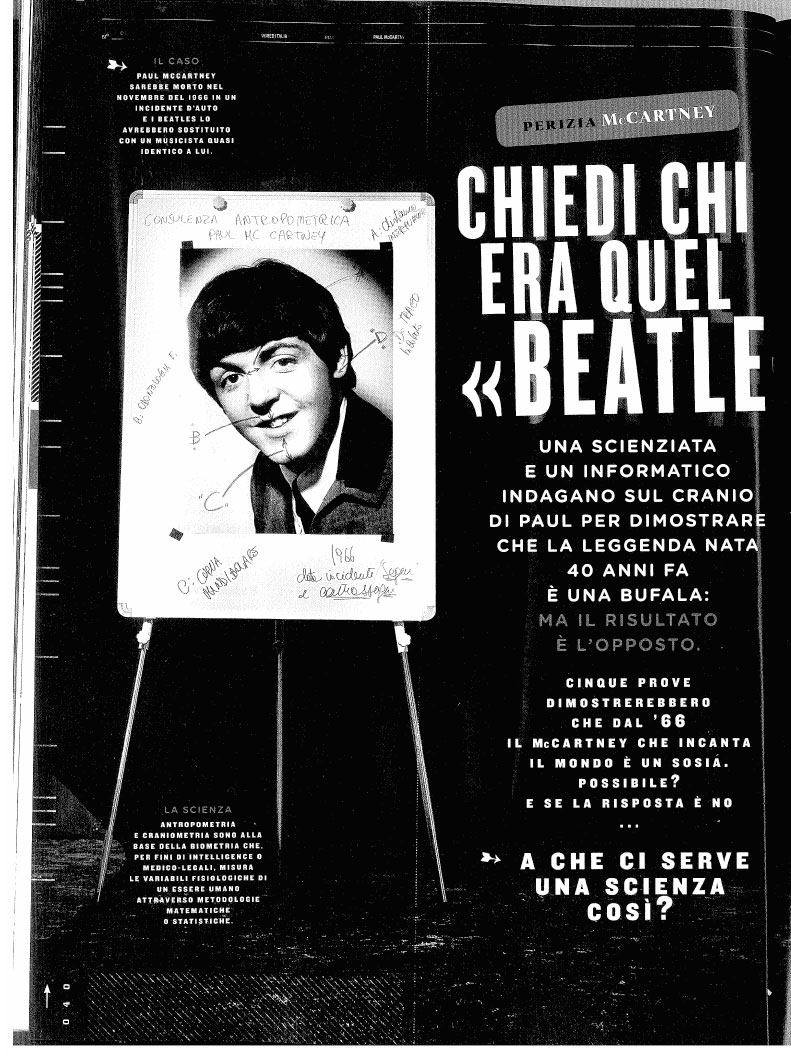
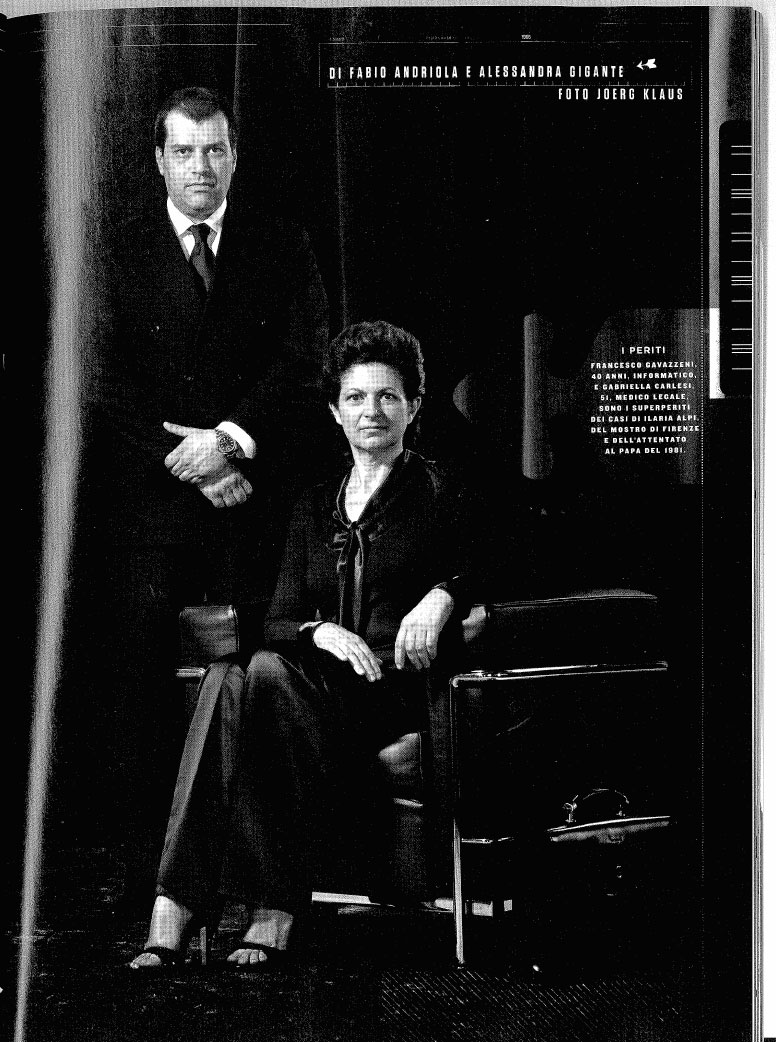
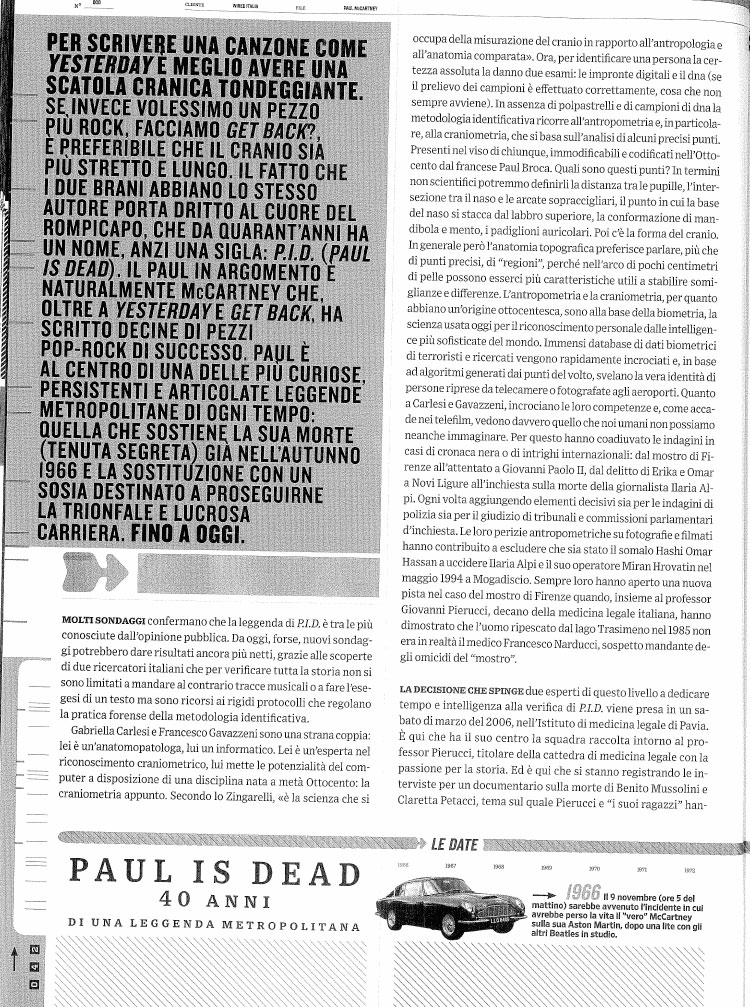
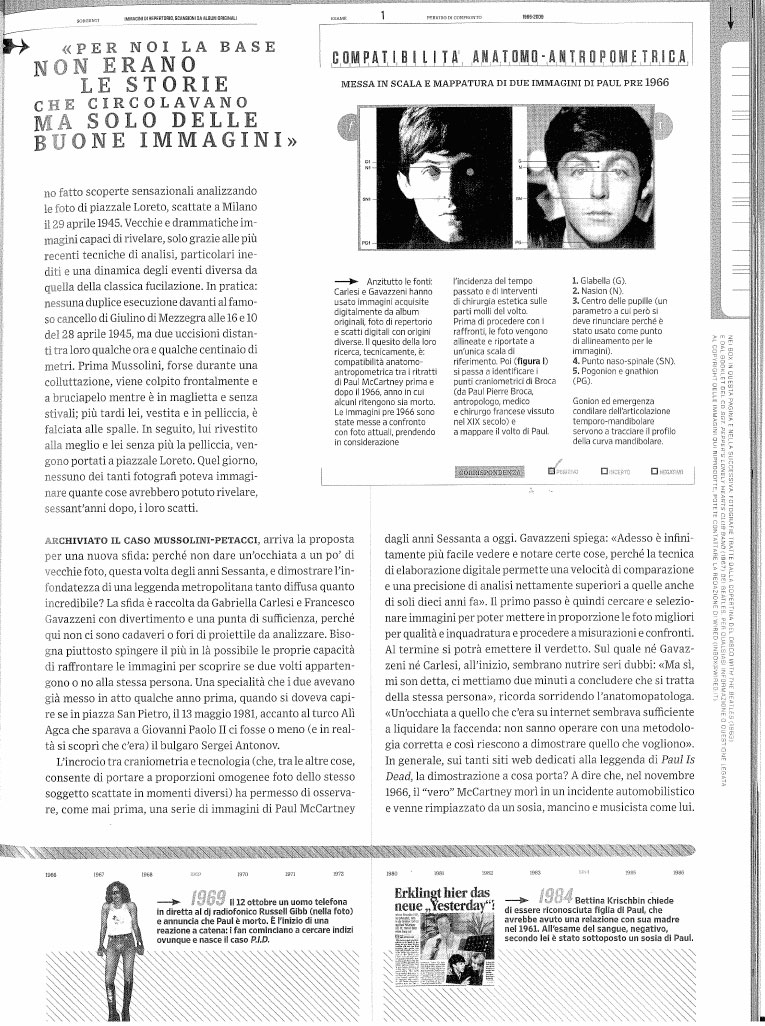
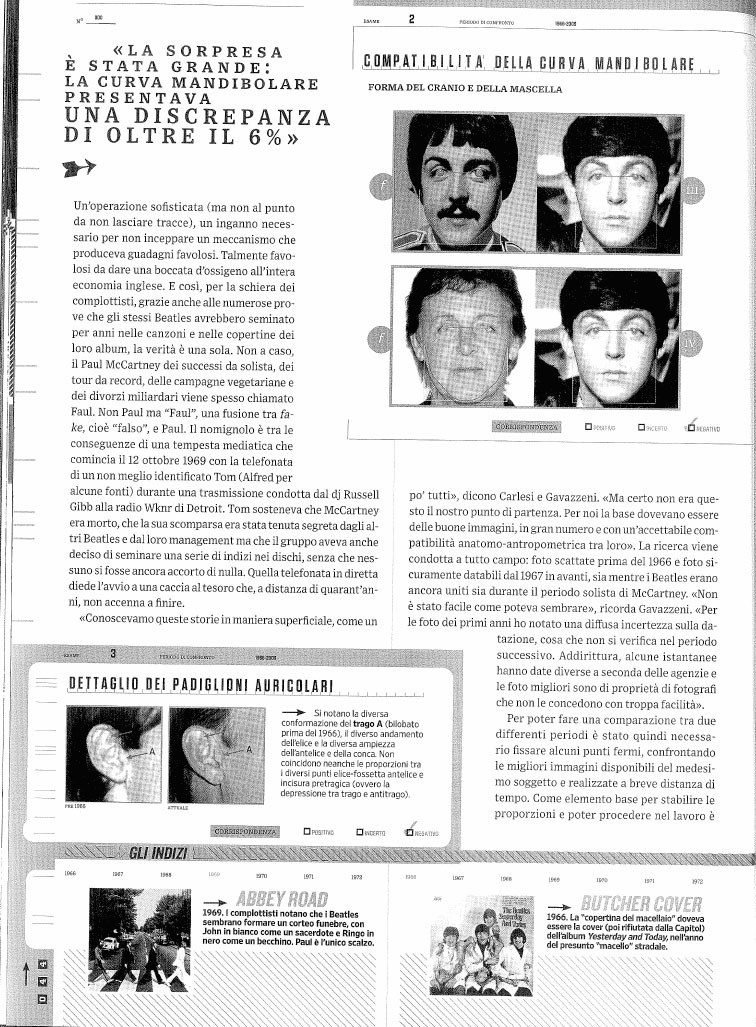
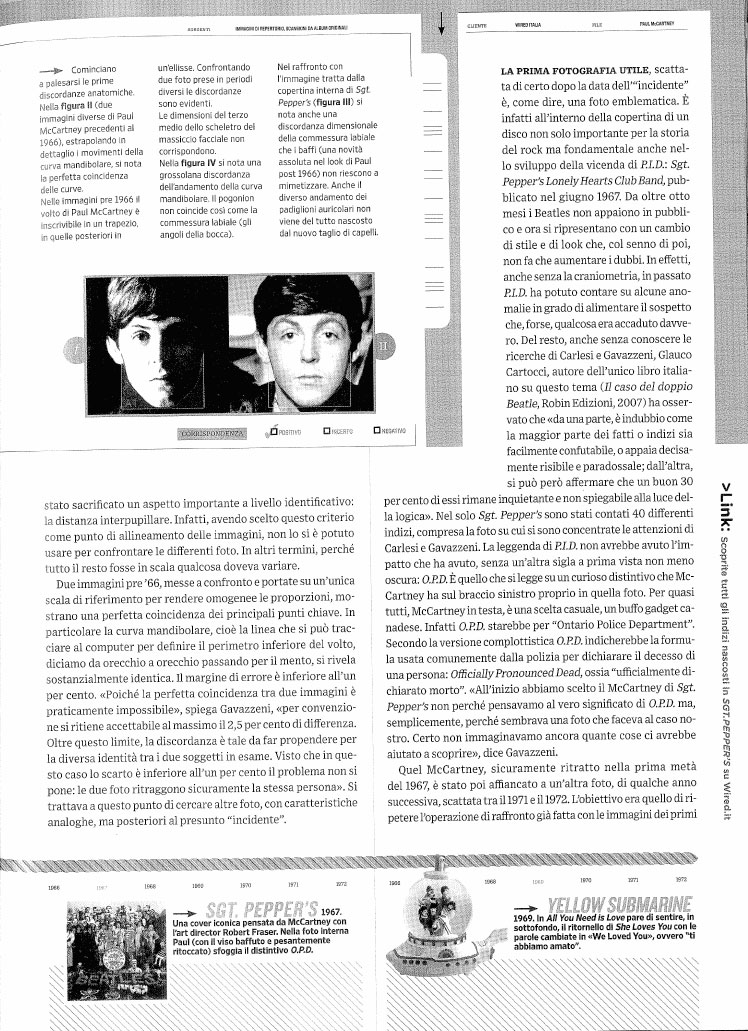
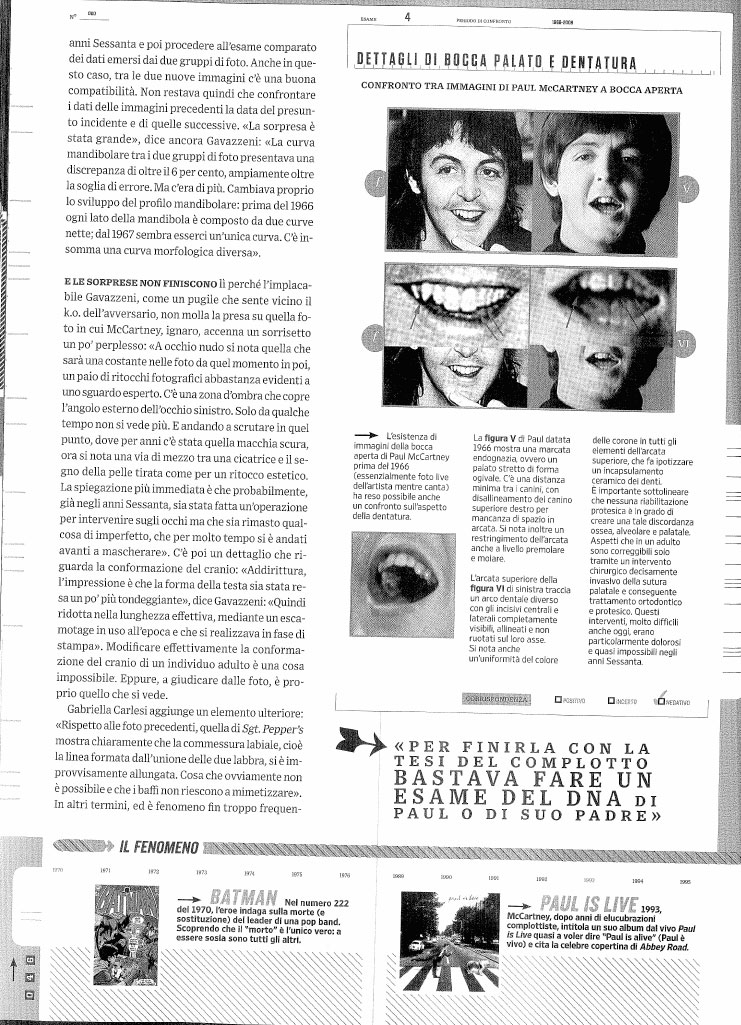
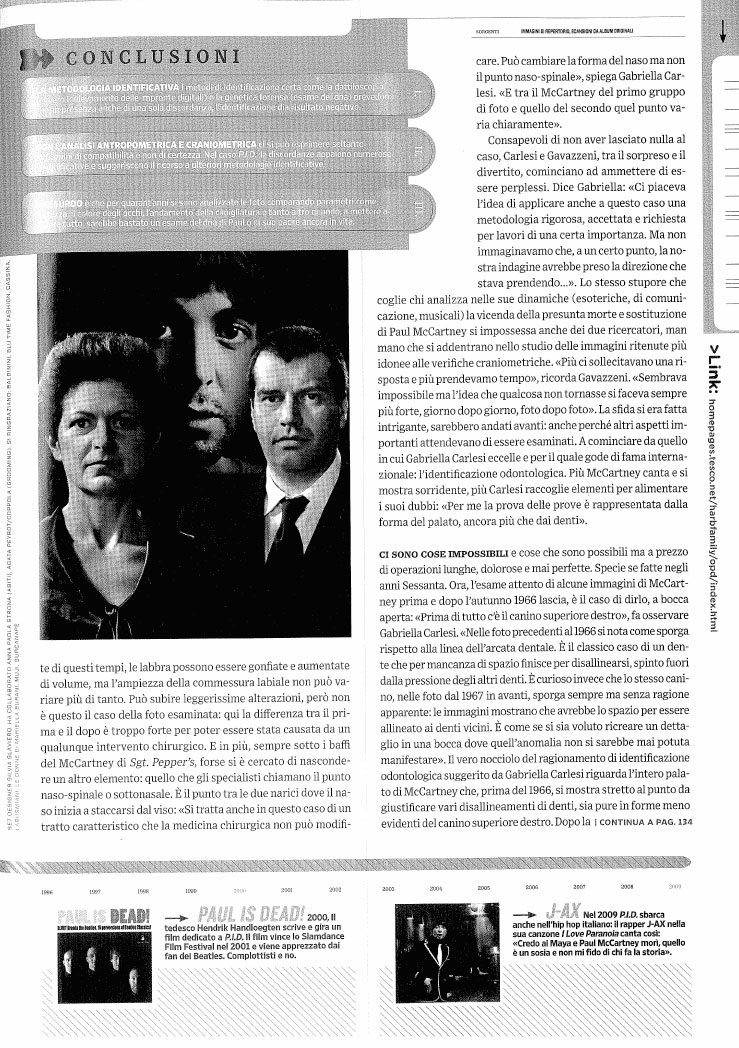
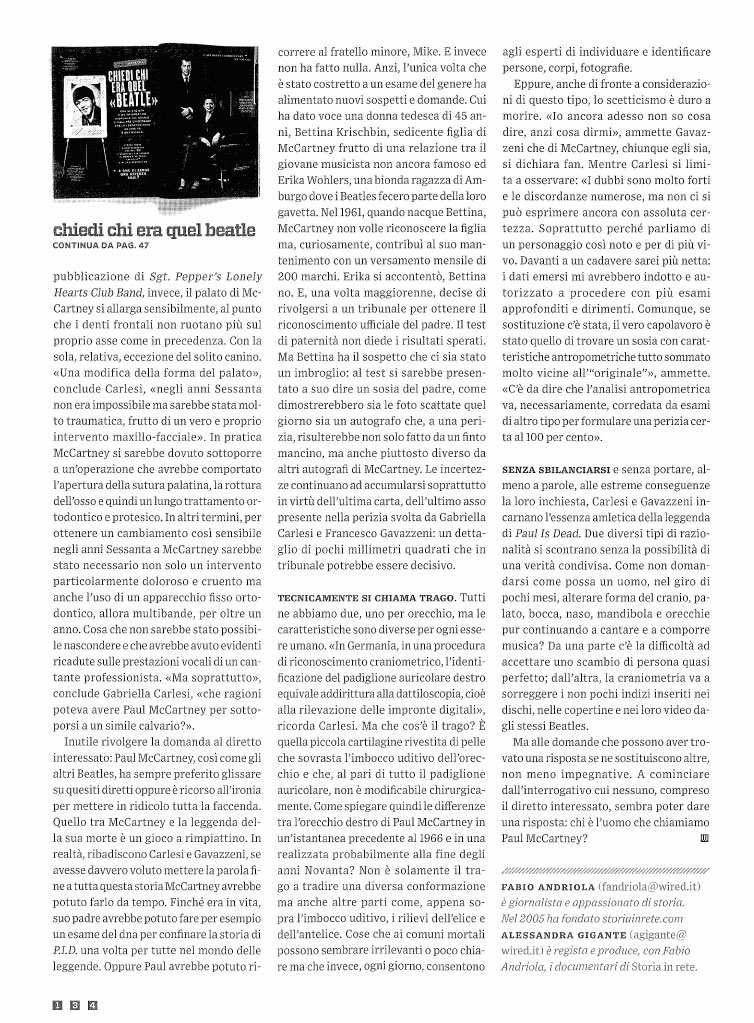

The following is a machine translation of the above
article into English.
ASK WHO WAS THE "BEATLE"
Fabio Gigante Andriola and Alessandra | 15 July 2009
Francesco Gavazzeni, 40 years, information technology, and Gabriella Carlesi, 51, medical legal, are superperiti cases of Ilaria Alpi, the monster of Florence and the attack to the Pope in 1981
Photo: Joerg Klaus
ASK WHO WAS THE "BEATLE"
Fabio Gigante Andriola and Alessandra | 15 July 2009
Francesco Gavazzeni, 40 years, information technology, and Gabriella Carlesi, 51, medical legal, are superperiti cases of Ilaria Alpi, the monster of Florence and the attack to the Pope in 1981
Photo: Joerg Klaus
To write a song like Yesterday is better to have a box round skull. If instead we wanted a bit more rock, we do Get back ", it is preferable that the skull is more narrow and long. The fact that the two songs have the same author leads straight to the heart of the puzzle, which for forty years has a name, even a symbol: PID (Paul Is Dead). The argument in Paul McCartney is obviously that, apart from Yesterday and Get back, has written dozens of pieces of pop-rock success. Paul is one of the most curious, persistent and articulate urban legends of all times: one that supports his death (kept secret), already in autumn 1966 and the replacement with a double to continue the triumphant and lucrative career. Until today.
Many surveys confirm that the legend of PID is one of the best known by the public. From today, perhaps, new polls could be even more clear, thanks to the discoveries of two Italian researchers to see that the whole story did not just send the music tracks or contrary to the exegesis of a text but appeals are hard to protocols that govern the practice of forensic identification methodology.
Gabriella Carlesi and Francesco Gavazzeni are an odd pair: she is un'anatomopatologa, he a computer scientist. She is an expert in the recognition craniometrico, he puts the potential of computers available to a discipline born in the mid nineteenth century: the craniometria note. According to Zingarelli, "is the science that deals with the measurement of the skull in relation to anthropology and comparative all'Anatomia. Now, to identify a person has absolute damage the two exams: the fingerprints and the DNA (if the sampling is done properly, which is not always the case). In the absence of fingertips and DNA samples of the methodology used all'antropometria identification and, in particular, to craniometria, based on some specific points. In the face of anyone, unchangeable and codified by the French nell'Ottocento Paul Broca. What are these? In scientific terms we could not define the distance between the pupils, the intersection between the nose and arched sopraccigliari the point where the base of the nose is detached from the upper lip, the shape of the jaw and Regulation, the ear. Then there's the shape of the skull.
In general, however, prefers to speak topographic anatomy, rather than specific points, to "regions", because within a few inches of skin can be more useful to establish similarities and differences. The Anthropometrics and craniometria, as have an nineteenth century are the basis of biometrics, the science used today for personal recognition by the most sophisticated intelligence of the world. Vast database of biometric data of terrorists are quickly and looked cross and, based on algorithms generated by the points of the face, reveal the true identity of people shot from cameras or photographed airports. As a Carlesi and Gavazzeni, meet their responsibilities and, as happens in the show, really see what we humans can not even imagine. To this have helped the investigation in cases of black or chronicle of international intrigue: the monster of Florence the attack to John Paul II, the murder of Erika and Omar in Novi Ligure in the death of journalist Ilaria Alpi Whenever adding elements is crucial for the police investigations or the proceedings of courts and committees of inquiry. Their expertise on anthropometric photographs and films have helped to rule out that it was the Somali Hashi Omar Hassan to kill Ilaria Alpi and Miran Hrovatin its operator in May 1994 in Mogadishu. Also they have opened a new runway in the case of the monster of Florence where, together with Professor John Pierucci, dean of medicine Italian, have shown that people retrieve from Lake Trasimeno in 1985 was in fact the doctor Francesco Narducci, principal suspect murders of the "monster".
The decision that pushes two experts of this level to devote time and intellect to check PID is taken in a Saturday in March 2006, at the Institute of Forensic Medicine of Pavia. It is here that has a center gathering the team around Prof. Pierucci, Professor of Medicine with a passion for history. And it is here that you are recording interviews for a documentary on the death of Benito Mussolini and Claretta Petacci, to which Pierucci and "his boys" have made sensational discoveries by analyzing photos of Piazzale Loreto, shot in Milan on 29 April 1945. Old and dramatic images capable of revealing only thanks to the latest analysis techniques, new details and a dynamic of events differs from that of classical shooting. In practice: no dual running of the famous front gate of Giulino Mezzegra to 16 and 10 of 28 April 1945, but two away from killing a few hours and a few hundred meters. Before Mussolini, perhaps during a colluttazione, was struck head-and-blank while it is in no shirt and boots, her latest, and dressed in fur, it's swath behind. Later, he played the best and she has no fur, are brought to the Piazzale Loreto. On that day, none of the many photographers could imagine how many things could reveal, sixty years later, their shots.
Closed the case Mussolini-Petacci, comes the proposal for a new challenge: why not take a look at some 'old photos, this time of the Sixties, and demonstrate an unfounded legend underground so widespread as incredible? The challenge is collected by Gabriella Carlesi and Francesco Gavazzeni with fun and a sense of sufficiency, because here there are no dead bodies or bullet holes to be analyzed. We have to push as far as possible their ability to compare images to find out if two faces belong or not to the same person. A specialty that the two had already put in place some years before, when you had to understand if in Piazza San Pietro, May 13 1981, next to the turkish Ali Agca who shot John Paul II there was or was not (and in fact it was discovered which there was) the Bulgarian Sergei Antonov.
The intersection between technology and craniometria (which, among other things, allows you to take photos similar proportions to the same subject taken at different times) has enabled to observe, as never before, a series of images of Paul McCartney from the sixties to today. Gavazzeni says: "Now is infinitely easier to see and notice certain things, because the technique of digital processing allows a comparison of speed and precision of analysis significantly higher than those of even just ten years ago." The first step is to then find and select images to be able to proportion the best photos for quality and range, and provide measurements and comparisons. At the end we will deliver the verdict. On which neither nor Carlesi Gavazzeni, at first, appear to have serious doubts, "But yes, I said son, we get two minutes to conclude that it is the same person," recalls the smiling Pathological anatomy. "Looking at what was on the internet seemed sufficient to settle the matter: do not know how to work with a proper methodology and so they can show what they want." In general, on many web sites dedicated to the legend of Paul Is Dead, demonstrating what door? To say that in November 1966, the "real" McCartney died in a car accident and was replaced with a double, and left-handed musician like him.
http://tinyurl.com/mw83db
A sophisticated (but not to the point that they leave traces), a deception is necessary to not clog the mechanism which produced impressive gains. So fabulous to be given a breath of fresh air to the British economy. And so, for the ranks of the plot, thanks to the many trials that the Beatles themselves have sown for years in the songs and covers of their albums, the truth is one. No coincidence that the success of Paul McCartney solo, tour record campaigns vegetarian billionaires and divorces is often called Faul. Not Paul but "Faul", a fusion between fake, that is "false", and Paul. The nickname is one of the consequences of a media storm that began on 12 October 1969 with a call from an unidentified Tom (Alfred for some sources) during a broadcast conducted by DJ Russell Gibb Wknr on the radio in Detroit. Tom claimed that McCartney had died and that his death was kept secret from the other Beatles and their management but that the group had also decided to sow a series of clues in the records, no one had even noticed anything. That phone call directly gave the start to a treasure hunt that, after forty years, no signs of ending.
"We knew these stories surface in a way, like a po 'all', and say Carlesi Gavazzeni. "But this certainly was not our starting point. For us to be the basis of good pictures, in great numbers and with an acceptable anatomical anthropometric compatibility between them. " The research is conducted across the photos taken before 1966 and certainly photos dating from 1967 on, both while the Beatles were still together during the period of solo McCartney. "It was not easy as it might seem," recalls Gavazzeni. "For photos of the early years I have noticed a widespread uncertainty about the dating, something that does not occur in the subsequent period. Indeed, some snapshots are different depending on the agencies and the best photos are the property of the photographers who do not give too easily. "
To make a comparison between two different periods was therefore necessary to lay down some markers, comparing the best available images of the same subject and carried out in rapid succession. As a basis for determining the proportions and be able to do work was sacrificed an important aspect in the identification: the distance interpupillare. In fact, they have this policy as a point of alignment of the images have not been able to use to compare different picture. In other words, because everything else was in the scale had to change something.
Two images pre'66, made a comparison and carried on a single scale of reference for making the same proportions, show a perfect coincidence of the main key points. In particular, the mandibular curve, ie the line that leads to the computer to define the perimeter of the lower face, say from ear to ear via the chin, is substantially identical. The margin of error is less than one percent. "For the perfect coincidence between two images is virtually impossible," says Gavazzeni, by convention it is considered acceptable at most 2.5 percent of difference. Beyond this limit, the divergence is such as to suggest the difference in identity between the two entities in question. Since in this case the spread is less than one percent, the problem does not arise: the two photos certainly depict the same person. " It was at this point to search for other photos with similar characteristics, but after the alleged "incident".
The first useful photo, taken of course after the date of the 'incident' is, as say, an image emblematic. It is inside the cover of a disc not only important for the history of rock but also crucial in developing the story of PID: Sgt Pepper's Lonely Hearts Club Band, released in June 1967. For more than eight months the Beatles do not appear in public and now again with a change of style and look that, in hindsight, does not only increase the doubts. Indeed, even without the craniometria, PID in the past could count on some anomalies that can fuel the suspicion that perhaps something had really happened. Besides, even without knowing the search for Carlesi and Gavazzeni, Glauco cartoccio, Italian author of the book on this subject (The case of double-Beatle, Robin Edizioni, 2007) noted that "on the one hand, there is no doubt that the majority the facts or evidence is easily rebuttable or appear laughable and decidedly paradoxical, on the other, but we can say that a good 30 percent of them remain unexplained and disturbing in the light of logic. " In only Sgt Pepper's were counted 40 different indications, including photos which have focused the attention of Carlesi and Gavazzeni. The legend of PID would not have had the impact that had, without a symbol at first sight no less obscure: OPD. That's what we read about a curious distinctive Mc-Cartney has on his left arm in that photo. For almost everyone, McCartney in the head, is a random choice, a gadget buff or Canada. OPD in fact going to "Ontario Police Department." According to the OPD complottistica indicate the formula commonly used by police to declare the death of a person: Officially Pronounced Dead, that is "officially declared dead." "Initially we chose to Sgt McCartney Pepper's not because we thought the true meaning of OPD. but simply because it seemed a photo that did the job. Certainly not even imagine how many things would have helped us to discover, "says Gavazzeni.
That McCartney, certainly portrayed in the first half of 1967, was flanked by another picture, a few years later, taken between 1971 and 1972. The aim was to repeat the operation of comparison already made with images from the early sixties and then proceed with comparative findings from two groups of pictures. Again, the two new images is a good compatibility. It only remains to compare the image data prior to the date of the alleged incident and subsequent ones. "The surprise was great," says Gavazzeni: The mandibular curve between the two sets of photos showed a discrepancy of over 6 percent, well beyond the threshold of error. But there was more. Changed the development of the mandibular profile: before 1966 each side of the jaw is composed of two curves Net, since 1967 appears to be a single curve. There is therefore a curve morphological different.
And the surprises do not end there because the relentless Gavazzeni, like a boxer who feels close the ko of the opponent, not the spring taken on the photo where McCartney, unaware, mentions a somewhat smug 'perplexed: "To the naked eye is known what will be a constant in the photos from that moment on, a couple of photo retouching fairly obvious to an expert eye. There is a gray area that covers the outside corner of left eye. Only for some time not seen before. And going to peep at that point, where for years there was one dark spot, now there is a cross between a scar and a sign of skin stretched like an aesthetic touch. The most immediate explanation is that probably, already in the sixties, has been made for an action on the eyes but it is still something imperfect, that for a long time has gone forward a mask. " Then there is a detail concerning the conformation of the skull: "Indeed, the impression is that the shape of the head was given a 'more rounded', Gavazzeni says:" So in the reduced effective length, by a trick used at the time and realized that being printed. Eff CTIVITIES change the conformation of the skull of an adult is something impossible. Yet, judging from the photos, is exactly what it shows.
Gabriella Carlesi adds an additional element: "Compared to the previous picture, that of Sgt Pepper's show clearly that the commessura lip, that is the line formed by the lips of the two, it was suddenly stretched. Which obviously is not possible and that the whiskers can not camouflage. In other words, the phenomenon is all too frequently these days, the lips can be inflated and increased in volume, but the width of the lip commessura can not vary that much. May be slight, but this is not the case for the photos examined: here the difference between the before and after is too strong to have been caused by any surgery. And more, always under the mustache of the McCartney Sgt Pepper's, maybe it was trying to hide something else: what the experts call it the nose-spinal or sottonasale. This is the point between the two nostrils where the nose begins to fall off the face: "This is also in this case a distinctive feature that medicine can not alter surgery. It can change the shape of the nose but not the nose-cord, "says Gabriella Carlesi. "And McCartney from the first group of photos and the second point that clearly varies.
http://tinyurl.com/mw83db
Aware of not leaving anything to chance, and Carlesi Gavazzeni between surprised and amused, are beginning to acknowledge that he is perplexed. Gabriella says: "We liked the idea of applying to this case, a rigorous methodology, acceptance and demand for work on a certain scale. But do not imagine that, at some point, our investigation would have taken the direction that was taking ...». The same awe that seizes those who analyze its dynamics (Esoteric, communication, music) the story of the alleged death and for Paul McCartney also takes possession of the two researchers as they go in the study of images deemed most suitable for checks craniometriche . "The more we asked for an answer and took more time," recalls Gavazzeni. "It seemed impossible but the idea that something you did not return ever stronger, day after day, pictures after pictures. The challenge was made intriguing, would go ahead because other important issues waiting to be examined. Starting with the one in which Gabriella Carlesi excel and for which enjoys international fame: dental identification. More McCartney sings and shows you smiling more Carlesi collects food items for his doubts: "To me the proof of evidence is the shape of the palate, yet more than the teeth."
There are impossible things and things that are possible but at the cost of operations long, painful and never perfect. Especially if done in the sixties. Now, careful examination of some pictures of McCartney before and after the 1966 autumn leaves, it must be said, in amazement: "First of all there is right upper canine," observes Carlesi Gabriella. "In the photos prior to 1966 is known as protruding relative to the line of teeth. It's the classic case of a tooth that lack of space it ends up misaligned, pushed out by the pressure of other teeth. It is curious that the same dogs in the photos from 1967 forward, but without ever protruding apparent reason: the images show that the space would have to be aligned with the neighboring teeth. It's like if you wanted to recreate is a detail in a mouth where quell'anomalia would have never been able to express. " The real crux of the reasoning of dental identification suggested by Gabriella Carlesi covers the whole palate of McCartney that before 1966, appears close to the point of justifying various misalignments of the teeth, although in less obvious forms of upper right canine. After the publication of Sgt Pepper's Lonely Hearts Club Band, however, the palates of McCartney widens considerably, to the point that the front teeth does not rotate on its axis more as before. With the only on, than the usual canine. "A change of the shape of the palate, Carlesi concludes, 'in the Sixties was not impossible but would be very traumatic, the result of an actual intervention maxillo-facial. In practice McCartney should have been subjected to an operation that would involve the opening of the suture palate, broken bone and then a long prosthetic and orthodontic treatment. In other words, for a change so sensitive in the sixties to McCartney would be required not only a particularly painful and bloody, but also the use of a fixed orthodontic multiband then, for over a year. Which would not have been possible to hide and would be obvious repercussions on the performance of a vocal professional singer. "But above all," concludes Gabriella Carlesi, "reasons that Paul McCartney might have to undergo such an ordeal?".
Needless to ask the question to the person concerned: Paul McCartney, as well as the other Beatles, he always preferred glisse on direct questions, or you all'ironia appeal to ridicule the whole affair. One between McCartney and the legend of his death is a game to rimpiattino. In fact, stress and Carlesi Gavazzeni, if he really wanted to put the word end to all this history McCartney could do so for some time. While he was alive, his father could do such an examination of DNA to confine the story of PID once and for all the world of legends. Or Paul could appeal to younger brother, Mike. But did nothing. Indeed, the only time I was forced to review the genre has fueled new suspicions and questions. Which he voiced a German woman of 45 years, Bettina Krischbin, McCartney's daughter called the fruit of a relationship between the young musician not yet famous and Erika Wohlers, a blonde girl in Hamburg where the Beatles made their Gavetta. In 1961, when Bettina was born, McCartney did not want to recognize his daughter but, curiously, contributed to its maintenance with a monthly payment of 200 marks. Erika satisfied, Bettina no. And, once adult, he decided to go to court to obtain official recognition of the father. The paternity test did not give the expected results. But Bettina has a suspicion that there has been a scam: the test was presented to him a double of his father, as both show the pictures taken that day is an autograph that, in a report, would not only done by a fake left-handed but also quite different from other autographs of McCartney. Uncertainties continue to grow primarily because of the card, the ace in this survey conducted by Gabriella Carlesi and Francis Gavazzeni: a detail of a few square millimeters in court that could be decisive.
Technically called trago. All we have two, one by ear, but the characteristics are different for every human being. "In Germany, a recognition procedure craniometrico, identification of the right ear even tantamount to fingerprint, ie the collection of fingerprints," recalls Carlesi. But what trago? It is the small cartilage covered with skin that overhangs the entrance to the ear and ear canal, like the whole ear, not be changed surgically. How then to explain the differences between the right ear of Paul McCartney in a previous snapshot to 1966 and probably a built in the late nineties? It is not only to betray trago a different conformation as well as other parts, just above the ear canal entrance, measurements and dell'antelice propeller. Things that ordinary mortals might seem irrelevant or unclear, but instead, every day, allowing the experts to locate and identify persons, bodies, photographs.
Yet, even in the face of such considerations, the skepticism is hard to die. "I still do not know what to say, but tell me what ', admits that McCartney Gavazzeni, whoever he is, declares fan. While Carlesi merely observed: "The doubts are very strong and the number of discrepancies, but we can not yet say with absolute certainty. Especially because we speak of a character well known and more alive. In front of a corpse would be more clear: the data would have led me emerged and allowed to proceed with more detailed investigations and dirimenti. However, if there was substitution, the true masterpiece was to find a double anthropometric characteristics with all things close to the 'original' "he admits. "It must be said that the analysis anthropometric be necessarily accompanied by other tests to make sure an expert at 100 percent."
Without lead and commit itself, at least in words, the ultimate consequences of their investigation, and Carlesi Gavazzeni amletici embody the essence of the legend of Paul Is Dead. Two different types of rationality collide without the possibility of a shared truth. How not to ask how can a man, in a few months, alter the shape of the skull, palate, mouth, nose, jaw and ears while continuing to sing and compose music? On the one hand there is the difficulty to accept an exchange of nearly perfect person, on the other craniometria goes to support the many signs posted in the discs, in portfolios and in their videos by the Beatles.
But the questions that may have found an answer if they replace other, no less demanding. Starting dall'interrogativo where anyone, including the direct question, it seems able to answer: Who is the man who called Paul McCartney?
The IF Paul McCartney died in November 1966 in a car accident and the Beatles were replaced with a musician almost identical to him.
SCIENCE craniometria Anthropometrics and are the basis of biometrics that, for purposes of intelligence or medical conditions, measure the physiological variables of a human being through mathematical or statistical methods.
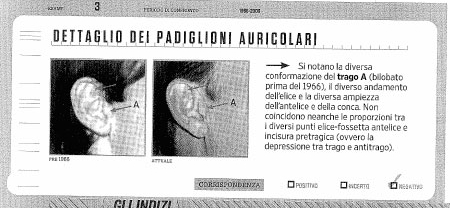
You can see the different conformation of piercing A (billobato
before the 1966) the different performance of ellce and
the different amplezza of antelice and of the valley. Do
not coincide even the proportions between the various
points Litania-from antelice and incisura pretagica (or
the depression between Piercing and antitrago).
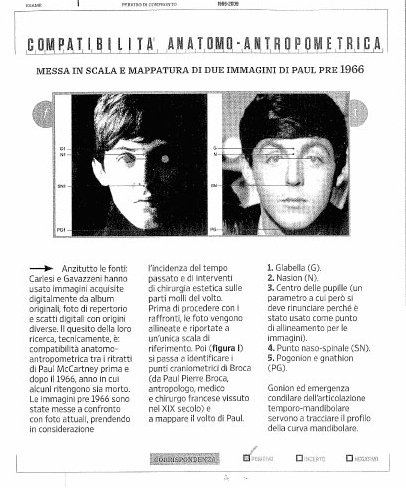
First of all the sources:
CARLESI and Gavazzeni have used images acquired digitally from album original, photos of repertoire and steps with a digital different origins.
The question of their research, technically, is:
compatibility anatomoantropometrica between the portraits of Paul McCartney before and after the 1966, the year in which some believe is dead.
The images pre 1966 have been put in comparison with photo current, taking into account the impact of time past and surgery
aesthetics on soft parts of the face.
Before proceeding with the comparisons, pictures are
aligned and given to a single scale of reference.
Then (picture I) you have to identify the points
of craniometrici Broca (by Paul Pierre Broca, anthropologist,
doctor and surgeon French lived
in the 19 th century) and mapping the face of Pau!.
1. glabella (g).
2. nasion (n).
3. Centre of pupils (a parameter that we should abandon because it has been
used as point of alignment for the images).
4. Point nose-cord (Sn).
5. pogonion and gnathion (PG).
condilare gonion and emergency of articulation time-mandibular
serve to determine the profile
CARLESI and Gavazzeni have used images acquired digitally from album original, photos of repertoire and steps with a digital different origins.
The question of their research, technically, is:
compatibility anatomoantropometrica between the portraits of Paul McCartney before and after the 1966, the year in which some believe is dead.
The images pre 1966 have been put in comparison with photo current, taking into account the impact of time past and surgery
aesthetics on soft parts of the face.
Before proceeding with the comparisons, pictures are
aligned and given to a single scale of reference.
Then (picture I) you have to identify the points
of craniometrici Broca (by Paul Pierre Broca, anthropologist,
doctor and surgeon French lived
in the 19 th century) and mapping the face of Pau!.
1. glabella (g).
2. nasion (n).
3. Centre of pupils (a parameter that we should abandon because it has been
used as point of alignment for the images).
4. Point nose-cord (Sn).
5. pogonion and gnathion (PG).
condilare gonion and emergency of articulation time-mandibular
serve to determine the profile
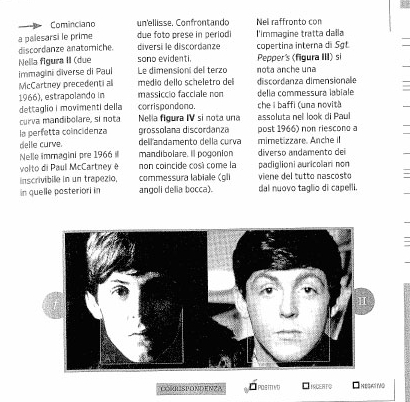
are beginning to arise the first discrepancies
anatomical in figure the (two different images of Paul
McCartney prior to 1966), extrapolating in detail the
movements of the curve mandibular, we note the perfect coincidence of curves.
In the images pre 1966 the face of Paul McCartney is inscrivibile in a trapeze,
in the rear in an ellipse, comparing two pictures taken in different periods
the discrepancies are obvious.
The size of the third medium of the skeleton of the massive facial not match.
In Figure IV shall note the rough discrepancy of the trend of the curve mandibular, the pogonion DOES NOT COINCIDE AS THE commessura speech (the corners of the mouth).
In comparison with the image is the cover internal Sgt. Pepper's (figure (iii) is also noted a discrepancy of dimensional commessura speech that the moustasches (a completely new nellook by Paul post 1966) are unable to camouflage. Also the different performance
of the pavilions headsets is not completely hidden by the new cut of hair.
movements of the curve mandibular, we note the perfect coincidence of curves.
In the images pre 1966 the face of Paul McCartney is inscrivibile in a trapeze,
in the rear in an ellipse, comparing two pictures taken in different periods
the discrepancies are obvious.
The size of the third medium of the skeleton of the massive facial not match.
In Figure IV shall note the rough discrepancy of the trend of the curve mandibular, the pogonion DOES NOT COINCIDE AS THE commessura speech (the corners of the mouth).
In comparison with the image is the cover internal Sgt. Pepper's (figure (iii) is also noted a discrepancy of dimensional commessura speech that the moustasches (a completely new nellook by Paul post 1966) are unable to camouflage. Also the different performance
of the pavilions headsets is not completely hidden by the new cut of hair.
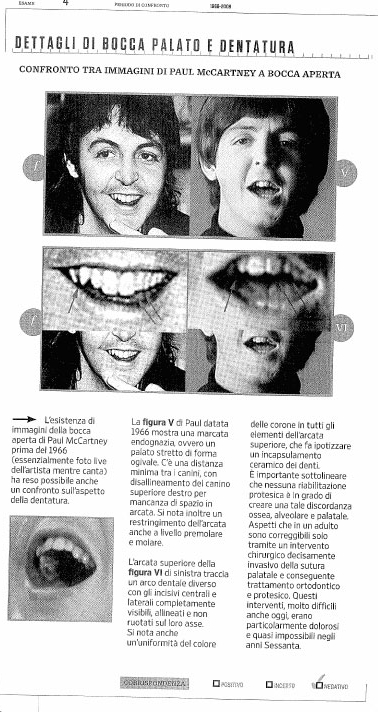
The existence of images of the mouth open of Paul
McCartney before the 1966
(essentially live pictures of the artist while he sings) has also made possible
a comparison on the look of teeth.
The figure v Paul dated 1966 show a marked endognazia, or a palate close to form
the ogiva. There is a minimum distance between the canines, with misalignment of
upper-right Canino for lack of space in Arch. There is also an arch of narrow chin
also at the level. And molar. The Arch over the figure you left track dental arch different with the incisors central and lateral completely visible, and not aligned rotated on their axis. There is also a uniform of the color of the crowns in all the elements of
arch superior, that is we expect a ceramic encapsulation of the teeth.
It is important stress that no prosthetic rehabilitation is able to
create a bone that discrepancy, cellular and palatal. Aspects that in a person
shall be only through a surgical very invasive the suturing palatal and consequent
orthodontic treatment and prostheses Co. these interventions, very difficult
today, were particularly painful and almost impossible in the 1960s
(essentially live pictures of the artist while he sings) has also made possible
a comparison on the look of teeth.
The figure v Paul dated 1966 show a marked endognazia, or a palate close to form
the ogiva. There is a minimum distance between the canines, with misalignment of
upper-right Canino for lack of space in Arch. There is also an arch of narrow chin
also at the level. And molar. The Arch over the figure you left track dental arch different with the incisors central and lateral completely visible, and not aligned rotated on their axis. There is also a uniform of the color of the crowns in all the elements of
arch superior, that is we expect a ceramic encapsulation of the teeth.
It is important stress that no prosthetic rehabilitation is able to
create a bone that discrepancy, cellular and palatal. Aspects that in a person
shall be only through a surgical very invasive the suturing palatal and consequent
orthodontic treatment and prostheses Co. these interventions, very difficult
today, were particularly painful and almost impossible in the 1960s
~ Tina Foster
Join the discussion:
PID Miss Him
forum